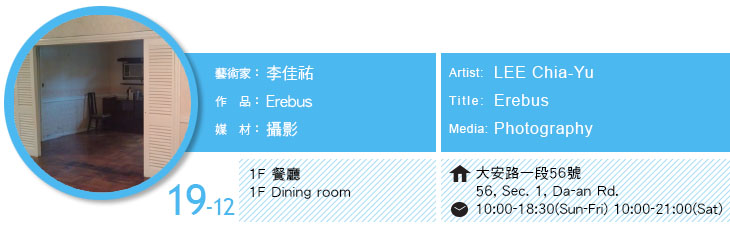









| 岩崎崇 | 張子隆 | ||
| 林怡芬 | 許旆誠 | ||
| 瑪莉娜克魯斯 | 張永達 | ||
| 朱盈樺 | 劉文瑄 | ||
| 大江慶之 | 戴翰泓 | ||
| 袴田京太郎 | 黃柏勳 | ||
| 似不像 | 杜珮詩 | ||
| 鍾舜文 | 賴易志 | ||
| 鄭秀如 | 楊‧弗門 | ||
| 游文富 | 海蒂‧渥特 | ||
| 黃彥超 | 池田朗子 | ||
| 康雅筑 | 徐薇蕙 | ||
| 劉瀚之 | 黃華真 | ||
| 宇治野宗輝 | 鍾順龍 | ||
| 澤拓 | 李佳祐 | ||
| 游文富 | 戴翰泓 | ||
| 瑪格妲‧賽耶 | 澤拓 | ||
| 陶亞倫 | 徐永旭 | ||
| 徐瑞憲 | 豪華朗機工 | ||
| 蔡筱淇、吉川公野 | 劉小康 | ||


每張家族的照片,都記錄著日常存在所遺留的痕跡。 璧面上一張張的照片,來自於藝術家李佳祐翻攝自家的家族老照片,它們像是證據一般,說明著「我」從何而來。它記錄下在「我」的存在之前,所不曾參與的世界;也因此,讓現在的「我」得以獲得「為何存在」的解答。 藝術家將每張照片拆解為黑與白兩畫面,在肉眼可及的能力下,每個畫面皆只能窺見少數細節,於是,當感官處於如此極限的狀態下,所有的不確定處,都將被觀者由自己的心靈補上互映的想像,並藉由觀者的內心形塑為真實。然而,當一黑一白的畫面兩者並置、同時觀賞時,單一畫面的細節會為另一畫面提供客觀線索;於是,客觀線索於此又將打斷我們在觀賞中所產生的內心想像。 客觀真實與主觀真實之間,就在過程中持續發生對立、消弭與支撐,也許,存在的真相,並不在它們任一者之中,而是在兩者共同構成的抽象空間裡。 |
Every family photo depicts a trace of the lives once lived. In Erebus, Artist Lee Chia Yu photographs some of his old family pictures as an attempt to explain the beginning of his existence, or “I”. The pictures document the world before “I” came into being and which “I” never took part in. For these reasons, the pictures hold the answer to the question “Why am I what I am?” The artist has produced two framed copies of each family picture, one black and one white. Barely visible, the images demand some effort from viewers’ eyes and leave the rest of their uncertainties to the viewers’ own imaginations. Placed side by side, the black and white pictures are complementary and provide objective clues that disrupt our newborn imaginations. While an ongoing process of conflict, elimination and support lies between the objective and subjective answers, the answer lies in neither but can be found in an abstract space resulting from collaboration. |
